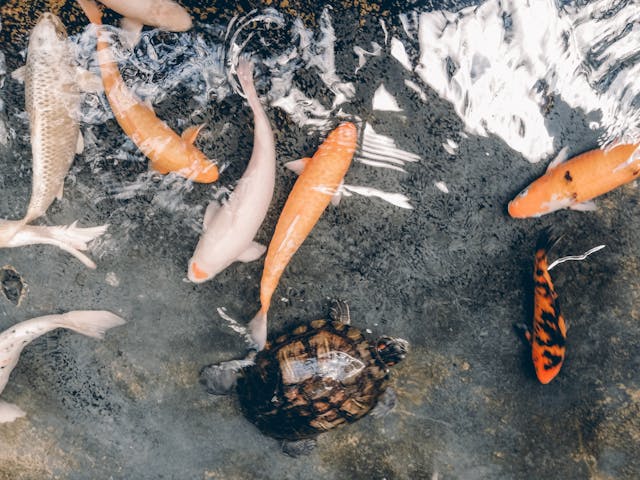With the warming weather, you may be out in your backyard more often. Have you ever found yourself considering installing a koi pond? Caring for these colorful fish can provide hours of pleasure, and simply watching them twisting and darting through the water can relax your mind. Raising koi in a backyard pond is different when compared to having an aquarium indoors—there are different steps to take to ensure your fish stay healthy and contented. Here’s what you need to keep in mind.
Koi characteristics
Learning what makes these fish unique is a good place to begin. The longevity of any species is important to know before you bring them home as a pet. Koi fish can grow to a very old age. Would you believe they can live for over 50 years? This means that having a koi pond is a serious commitment.
The other characteristic to take into account is their size. Sure, they may look small and cute when you see them at the store, but these beautiful swimmers can grow an incredible 36 inches, or three feet, in length. That said, their size at maturity depends on the kind of koi you select. There are many different types, although all are variants of the common carp.
Be aware that koi can be harder to care for than other types of fish. However, if you already have some experience with pet fish, you’re in a reasonably good position to acquire the additional knowledge you need to own koi.
Interestingly, a fun fact about this fish species is that they are smart enough to recognize their owners. Over time, you can form a lovely bond with these creatures and enjoy many happy years parenting them.
Setting up your koi pond
Koi are large fish, and your pond should be able to accommodate several of them, since this species does not like to live alone. Most koi experts recommend that ponds be able to hold at least 1,500 gallons of water; the pond should be about 6-7 feet by 8 feet and 4 feet deep, at the minimum. An area of the yard with partial shade is best, and the water should ideally be about 65-75 degrees Fahrenheit. In the winter, koi can survive if the pond freezes over, but the water must be deep enough so that it doesn’t completely turn to ice.
Your pond should have a proper liner made of PVC or rubber so that it doesn’t leak. Unless the bottom and sides are made of concrete, which is another good option, you’ll need gravel or rocks to keep the liner from shifting. Adding plants will help balance oxygen levels in the water and disburse nutrients.
Purchase a good-quality water pump to ensure the water is well aerated. Filters and skimmers that sit near the waterline or just under the surface are needed to make sure the water remains fresh and clean, with minimal debris and bacteria. Again, give some thought as to the best skimmers and filters for the job.
The equipment you select should be installed with a system of piping that will connect the drains, filters and pumps. The pipes will assist to manage storm water so that it doesn’t cause an overflow in the koi pond. The particular kind of equipment you need will depend on a few things ─ namely the weather patterns where you live and the place in your garden you designate for your pond.
Keep your koi well cared for
Once you have your pond up and running, release your koi into the pond slowly. This is best accomplished by first observing them in a tank for a few weeks to be sure that they are healthy. Then, place them gently into the pond inside a water-filled bag until the temperature of the water in the bag reaches the temperature of the pond water. This should take about 10 minutes and will ease their transition.
Your pets are omnivores. In other words, they subsist on a diet of meat and vegetables. Offer them high-quality food that has sufficient protein, following the package instructions and your veterinarian’s advice about how often to feed your koi and what amount. You’ll notice that the better the food, the more colorful your fish. Expect that your pets to be less hungry during the colder months; this is perfectly natural as they slow down somewhat and need fewer calories then.
Try to feed your fish from the same spot in the pond each time. They’ll quickly learn when it’s meal time and be ready and waiting for you. Take care to avoid feeding them near the filter so that the food doesn’t become swept into this equipment before your fish can finish their meal.
It’s critical that you check the water quality in the pond regularly. This involves testing for ammonia, copper, iron, lead, nitrates, and zinc. You also need to examine the oxygen level and the pH of the water. To check these numbers, use a testing strip at least once a week and more often in the event of a storm or if you’ve changed some of the water. In addition, consider introducing beneficial bacteria to balance ammonia and nitrate levels and inhibit the growth of algae.
Finally
Remember to follow standard sanitary procedures such as washing your hands with warm soapy water and rinsing thoroughly before and after dealing with your pets. This will keep both you and your koi from contracting certain illnesses.

